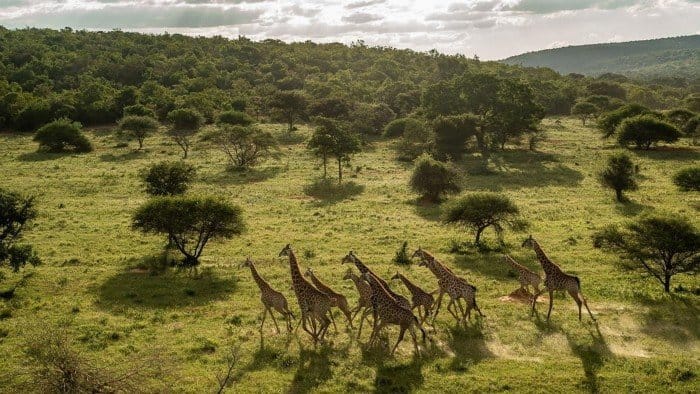“Ah,” said my husband Robert, “there they are,” and gestured with cautious excitement to his left.
It was late on a Sunday afternoon, and we’d been driving for some time through the Lapalala Wilderness Reserve in Limpopo Province, three hours north of Johannesburg by car. We were the sole passengers in a large, open-sided 4×4 driven by our ranger Brendan Volkner, who now and then had paused the vehicle to examine the lion tracks that flanked the narrow road through the bush. “Yes,” said Robert, “look.” Obediently I peered into the distance. “No”, he said, perhaps by now a little tautly, “there!”
And there they were — just feet away, with nothing between us but a few bare branches — a pair of young lions, sated on a recent kill, lounging for all the world like contented domestic cats. I was thunderstruck. I’d hoped for perhaps a fleeting glimpse of a mane disappearing between trees: it had simply not occurred to me that we’d draw so close to the king of beasts.
I looked at Brendan, expecting him to reverse the vehicle so that we could observe from a safer distance. Instead, he turned off the engine, and for 10 minutes or so we shared with the lions an untroubled and companionable silence, at such close quarters that I could count their whiskers. “You know”, said Robert, dazedly, “I think they have the kindest faces I have ever seen.”

We’d arrived in Lapalala only that morning, greeted by Brendan at the gate with snacks of biltong and preserved mango set out on the bonnet of the 4×4. The reserve — occupying 48,000 hectares of land, which is to say considerably more than the Isle of Wight — was created in the 1980s by conservationists Dale Parker and Clive Walker, who purchased a number of farms in the area to create a reserve for the reintroduction and protection of the endangered black rhino.

Lapalala is now home to Lepogo Lodges, which is run by Kate Hughes as one of the few entirely not-for-profit safari lodges in South Africa. Lepogo consists of Noka Camp — five villas resembling broad canvas tents, pitched on a rocky bluff above the Palala river roaring several hundred feet below — and the new Melote House, a private retreat for up to 16 built into a hillside about five miles away.
At Noka, where we are staying, the villas, restaurant, bar, shop and gym are reached by a series of boardwalks elevated above the bush; the impression is almost of transience, and of a complex that sits lightly on the earth. This impression is in keeping with the Lepogo ethos: the reserve is off-grid and entirely solar-powered, with all profits used to fund conservation projects, including the reintroduction of the cheetah to the reserve (lepogo being the Sotho word for “cheetah”).

The tent-like look of the villas is purely aesthetic: once through a single, immense wooden door, you’ll find nothing remotely akin to camping. A villa intended for two could readily accommodate a family of five without anybody getting on anybody’s nerves: there’s a stylish living area, in which comfortable seating gathers about a wood-fired stove, and where a bar is kept stocked with drinks tailored to guests’ tastes, together with glass jars of snacks and, in the evenings, a “goodnight sweet” that changes daily.
A large bed faces the long, glassed wall, offering an uninterrupted view of the Palala, and the bush on its far bank. Outside, on a balcony made private by the absolute isolation of the reserve and by louvred screens between the villas, there is a small infinity pool heated to the point of steaming in the chilly mornings.
A further balcony provides a “star bed”, which may be made up on request to permit guests to sleep under the constellations. Despite the maddening brightness of a full moon obliterating our longed-for glimpse of the Milky Way, we lay there one evening clutching hot water bottles, lulled by the roar of the river.


As we departed the bush that first afternoon, Brendan explained the lions’ benign indifference. Setting aside the reintroduction and protection of endangered species, Lepogo aims to be a neutral presence in the bush, with the vehicles used for viewing game a familiar but essentially useless sight to the animals, offering neither benefit nor threat.
This — together with its location in a vast and little-populated space — permits close-quarters viewing of a bewildering variety of species untroubled by humans, so that within our first 48 hours we’d seen a southern white rhino ambling by with her young calf, several giraffe flaunting it like models on a catwalk, and lions feasting on a recently slaughtered wildebeest, observed by black-backed jackals waiting for scraps as patiently as labradors beneath a dining table.


Now and then a series of tableaux would appear in which various species fraternised peaceably in the shade: zebra, with the surreal clarity of their stripes forming symmetrical loops on their faces; ochre-coloured red hartebeest, with horns like recurved bows; and the kudu antelope, their flanks delicately traced with white stripes that resembled the stems of the long grasses in which they stood. Meanwhile, we often saw hamerkops fly overhead, the backwards slope of the bird’s heavy crest giving the impression of a prehistoric animal outlasting time.
I am not sure what I expected from a South African winter, but it seemed to me startlingly lush, with many of the trees still in leaf, and grasses at shoulder height displaying delicate five-fingered seed-heads (often we were told we really ought to see the place in summer, with flowers everywhere, and clouds of butterflies settling on the roads). There’d been recent heavy rain, which here and there had washed the red topsoil from the roads and left our vehicle jostling over rocks; the Palala river and the streams that crossed the bush elsewhere were running high and fast.
I’d often heard the continent of Africa described as “the cradle of civilisation”, and it occurred to me — as we moved past a towering marula tree, with its medicinal bark and its sweet fruits that each summer draw herds of peckish elephants — that had there been a garden of Eden, it must have resembled this simultaneously wild and hospitable land.

The following morning, however, winter rather spitefully asserted itself. It’s all very well maintaining a certain commitment to style, but it turns out that a Burberry trenchcoat is no match for seven o’clock on a Limpopo July morning. We bundled into our vehicle for our first early game drive, and — though well supplied with hot-water bottles and blankets — the cold wind penetrated my clothing and my ears, so that I thought longingly of languorous poolsides in, say, Mauritius.
But soon those extraordinary tableaux of bush life presented themselves again, with kudu and zebra grazing together at their breakfast, and I forgot my numbing hands. Then, as the sun rose and the chill relented, a pair of lions sauntered out of the bush ahead of us. We followed slowly, admiring their loping swagger and their casual, assessing glances from left to right: it was remarkable to observe not only different species, but different characters within species, these older lions having the look of a biker gang menacing a high street, compared with the sleepy, almost kittenish brothers of the day before.
The lions headed with some secret purpose back into the bush and, after driving for a time, Brendan paused the vehicle some distance from a bend in the river where a little lake known as the Elephants’ Pool had formed. “Let’s head down here”, he said, as if the thought had just occurred to him, and obediently we picked our way down the smooth, worn rocks to the banks. Here breakfast awaited, with Persian rugs and velvet cushions set out at the water’s edge for us to lounge on, together with wooden chairs and a table. A short distance away, staff already familiar to us from the Noka Camp restaurant were preparing a meal under a gazebo — so we drank good coffee and bucks fizz, and followed fruit and coconut yoghurt with bacon and eggs.


Despite the name “Elephants’ Pool”, there was no sight of elephants that day or any other day, however diligently we followed their tracks of vast ovoid thuds in the dusty soil, mottled something like an anatomical drawing of a brain. This might have been disappointing had we not taken such pleasure in tracking a bull elephant up into a forested hillside, where — as we had our daily “sundowner” of wine and snacks — we listened to the unmistakable sound of the bull diligently felling trees in order to dine on their roots and canopies.
That afternoon, we visited Lapalala Wilderness School, its main building an award-winning fusion of contemporary architecture and traditional packed-mud construction. The school’s director, Mashudu Makhokha, explained the school’s origins more than 40 years previously, when it had consisted of little more than a few tents by the river, and when its determination to empower children from the local community with an environmental education had drawn the suspicion of the apartheid government.
The school is now partly funded by Lepogo as part of its not-for-profit operating model, and over the intervening years has worked with 200,000 local children from more than 80 schools, aiming to create — as Mashudu put it — an environmentally literate society that “leaves nobody behind.”
The next day, we saw another significant strand of Lapalala’s conversation work, as we went out with the anti-rhino poaching squad. Since rhino horn can fetch upwards of $60,000 per kilo — largely for the purposes of traditional Chinese medicine — the protection of the reserve’s rhinos, which include the critically endangered black rhino, is paramount. So it was that we found ourselves briskly walking through the bush accompanied by armed staff, together with their most important colleague: a small and amiable dog called Louis, trained to follow a scent trail deep into the bush. When — with quite remarkable speed and single-mindedness — he tracked our ranger Brendan to where he waited crouching behind a bush, Louis was rewarded with his beloved stuffed octopus toy, which he carried triumphantly all the way home.
On our final day, the notion of the African continent as the birthplace of civilisation occurred to us more forcibly than ever, as we crossed a river on foot (a little wary, it must be said, of hippo and crocodile) in order to view art created by the hunter-gatherer San people and preserved on a rocky ledge.

San cave paintings in Namibia have been dated to 27,000 years old — though there has been speculation that the San date back to at least 100,000 years. The San rock art at Lapalala is believed to be between 150 and 1,500 years old, perhaps augmented and maintained over the course of generations. To see it, and to sit with it for a time beside the shallow river, was extraordinarily moving.
The art consists of a series of etiolated but perfectly recognisable representations of kudu antelope, together with humans in various erotic or ritualistic poses; here and there loops and lines are used to group figures together, or are suggestive of music notation, all rendered in a soft, reddish pigment probably made from ochre, animal fat, and blood. I was left with a lasting impression not of the immense distances of space, culture and time that separate me now from that art, and the hands that made it, but rather of companionship.
That evening back at Noka Camp, where all week we’d dined on elegant portions of restaurant food, I asked if we could instead eat some local, homely food. So our last meal in Lapalala was also our best: we ate pap, the staple carbohydrate of ground maize, together with perfectly grilled steak and beef sausage, and ladles full of rich, peppery chakalaka sauce.



In the aftermath of travel, I am sometimes surprised by the sifting of memories, and by what recurs to me most vividly. Certainly I remember the cheetah and her cub lipsticked with blood as they set about their supper; certainly I remember Robert summoning me before breakfast to watch a family of baboons waking on the cliff above the river and barking cheerfully at each other.
But what I recall most fondly is a moment early one morning when a small bird sat for a time on a branch nearby, placidly surveying our vehicle, and joining the dawn chorus. It was a crimson-breasted shrike, and the full length of its breast and underbelly was red as a cardinal’s robe — the truest and most startling scarlet I have ever seen on any living thing, and surmounted by slender black wings slashed with white.
“Hear that?” said Brendan, raising his hands as if conducting the birdsong. “That’s what I call the Hallelujah Chorus. They’re singing, ‘Here I am! Here I am! I made it through the night — and isn’t it a good day to be alive?’”
Sarah Perry’s most recent novel is ‘Enlightenment’; her new memoir ‘Death of an Ordinary Man’ is published on October 2 (both Jonathan Cape)
Details
Sarah Perry was a guest of Lepogo Lodges (lepogolodges.com). Staying in a two-person villa at Noka Camp costs from R18,450 (£790) per person per night, full-board and including conservation levies and twice-daily guided safaris on foot, by 4×4 and boat.
Find out about our latest stories first — follow FT Weekend on Instagram, Bluesky and X, and sign up to receive the FT Weekend newsletter every Saturday morning



